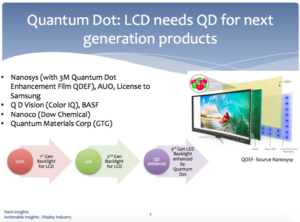If you’ve ever wanted to step back to get a view of the ‘forest for the trees’ look at the display industry trends, then look no further than the recent talk given by long-time industry guru Sweta Dash. Beyond her benchmark work at helping to build IHS into the global market research powerhouse it is today, Dash is now the founding president and principal of Dash Insights. She took time out of her busy schedule to present her talk on Emerging Display Trends to the Pacific Northwest Chapter of SID in Beaverton, OR.
Dash’s talk tackled some of the most vexing issues we face as an industry today, including: ‘Auto Displays – What is Driving Growth?’; Flexible Displays – is it Ready For Mainstream?’ ‘High Resolutions (UHD, 4K, 8K, High Color Gamut, HDR) – Where is the Industry Going?’ Quantum Dot – Is it The Next Generation LCD?’; and ‘OLED Display – Will it Replace LCD in Next 3-to-5 Years?’
Now readers of these pages (and particularly subscribers of the newsletters) will have no problem in answering these questions above, but it’s nice to see them all come together in one solid presentation from Ms. Dash. So here’s the short cheat sheet in case you’re interested in taking a peek.
Dash Insights QD presentation to PNW SID June 2016, Source Dash InightsAuto Display: this application will enjoy the most dynamic growth, driven by connected and smart vehicles. Well, OK, that’s pretty much a ‘no brainer,’ but what Dash likes about the auto display market is the fact that it is the one place where multiple display technologies co-exist and so being, represents the next battlefield where multiple display options will be fighting it out for dominance. Think of it, in one car you can find an OLED, LCD, even STN display, plus projection used for a HUD system. Each technology will come with its own set of challenges, (bendable form factor for LCDs for instance) but a clear winner in the space is anyone’s guess.
Flexible Display: will see strong growth, faces challenges to be mainstream in mobile and wearable. Growth continues with flexible display. Dash explained that in this space we are still challenged by supply, process, and yield issues (…still two years out, again) plus cost, the real benefit of true flexibility, and even demonstration of a real mainstream market that has yet to emerge. No one doubts that flexible displays can dominate the wearable market, but that space will not generate the high area sales needed to drive profitability. So the current situation is that cost remain high, yields low and the future uncertain, as a breakthrough product has yet to emerge.
These next three issues are all inextricably linked, according to Dash (yes we agree!)
High Resolution: TV – UHD, HDR, WCG, large size – needed for product differentiation and replacement demand growth. ?
Quantum Dot: enables next generation LCD re-invention ?(LCD needs QD not the other way around…)
LCD: continue to be dominant in its evolutionary form but will lose market share in some applications and ?will struggle in flexible display; new solutions may help.
Here Dash offered thoughts that turned to the TV and just how it has progressed through the flat panel era. When CCFL’s were the dominant backlight technology, wider flat screen displays began to mature, until the ‘micro cycle’ of LED-driven backlights, and voila, the technology re-invented itself. Today high resolution, UHD, high dynamic range, wide color and larger sizes all contribute to the LCD technology product differentiation that helps drive yet another micro cycle in the space. But to Dash its really QD technology that will take the lead here, with it’s potential to deliver an “emotional experience” to the consumer that will increase demand and drive the next generation of TVs forward (not OLED…)
With the subsequent generations of QD applications, (including integration into the LED itself) the LCD can morph again and again, creating that elusive moving target and making it difficult for OLED to keep up, let alone dominate, in the king of display markets known as the living room TV.
?That brings us to the final topic, OLEDS and the Dash prediction:
OLED: the technology is emerging, but can’t replace LCD even in 2020 in terms of area.?There will be rapid growth in mobile and wearable, but OLED will struggle in TV. To Dash, OLEDS in TV isn’t really about the best solution as much as it is the good enough solution at a reasonable price that will win in the long run. So while OLEDS can look better, in the next five years, a thin (ok not as thin as OLED), QD-enhanced flat panel LCD at way lower price is still just too hard to beat. And just a reminder, in large size displays, OLED’s are still just a rounding error in both unit volume and revenue when compared to LCD.
Special thanks to Sweta Dash for her presentation to our local PNW SID chapter. It was truly ‘Insightful’. Steve Sechrist

